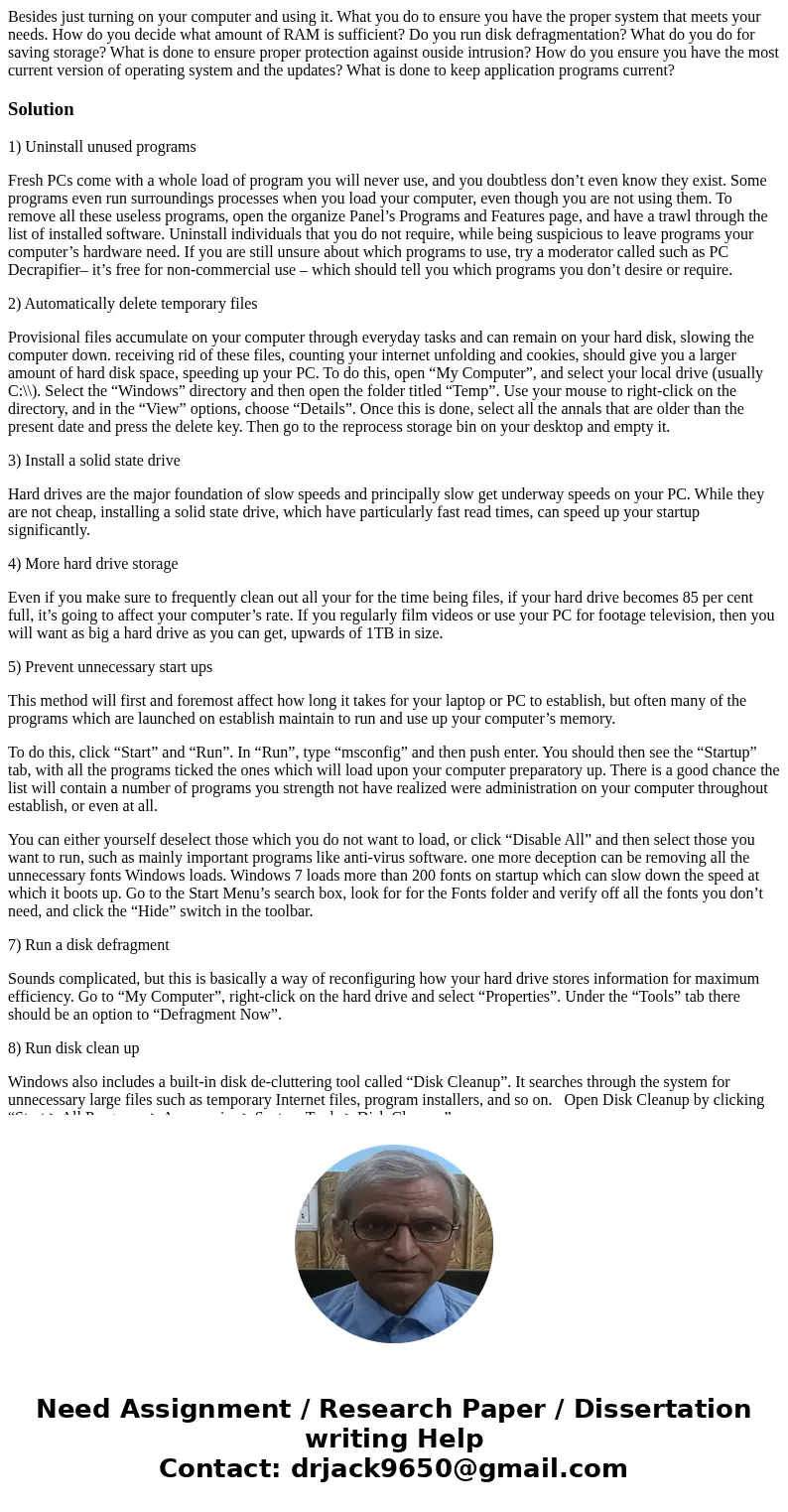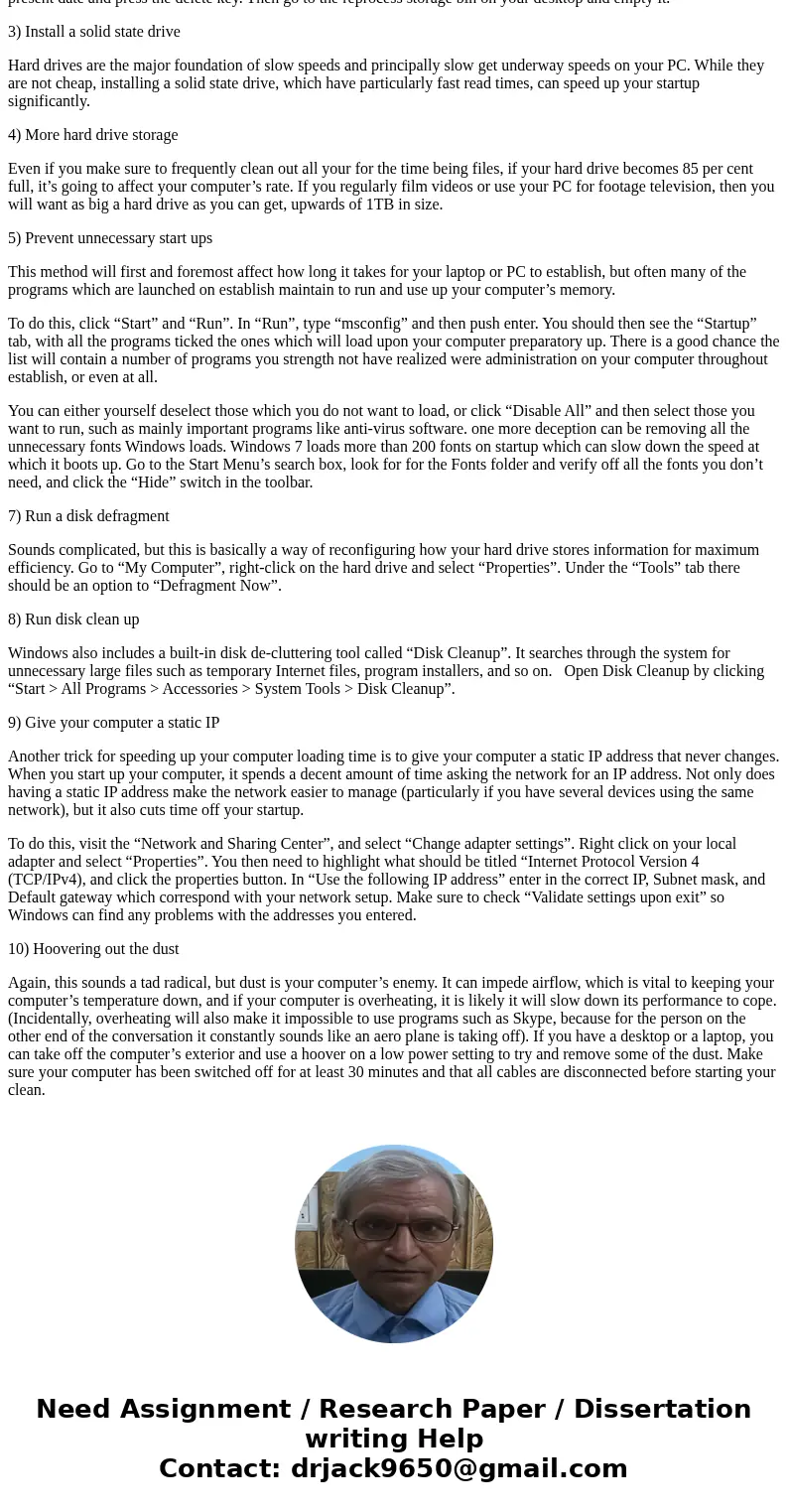Besides just turning on your computer and using it What you
Besides just turning on your computer and using it. What you do to ensure you have the proper system that meets your needs. How do you decide what amount of RAM is sufficient? Do you run disk defragmentation? What do you do for saving storage? What is done to ensure proper protection against ouside intrusion? How do you ensure you have the most current version of operating system and the updates? What is done to keep application programs current?
Solution
1) Uninstall unused programs
Fresh PCs come with a whole load of program you will never use, and you doubtless don’t even know they exist. Some programs even run surroundings processes when you load your computer, even though you are not using them. To remove all these useless programs, open the organize Panel’s Programs and Features page, and have a trawl through the list of installed software. Uninstall individuals that you do not require, while being suspicious to leave programs your computer’s hardware need. If you are still unsure about which programs to use, try a moderator called such as PC Decrapifier– it’s free for non-commercial use – which should tell you which programs you don’t desire or require.
2) Automatically delete temporary files
Provisional files accumulate on your computer through everyday tasks and can remain on your hard disk, slowing the computer down. receiving rid of these files, counting your internet unfolding and cookies, should give you a larger amount of hard disk space, speeding up your PC. To do this, open “My Computer”, and select your local drive (usually C:\\). Select the “Windows” directory and then open the folder titled “Temp”. Use your mouse to right-click on the directory, and in the “View” options, choose “Details”. Once this is done, select all the annals that are older than the present date and press the delete key. Then go to the reprocess storage bin on your desktop and empty it.
3) Install a solid state drive
Hard drives are the major foundation of slow speeds and principally slow get underway speeds on your PC. While they are not cheap, installing a solid state drive, which have particularly fast read times, can speed up your startup significantly.
4) More hard drive storage
Even if you make sure to frequently clean out all your for the time being files, if your hard drive becomes 85 per cent full, it’s going to affect your computer’s rate. If you regularly film videos or use your PC for footage television, then you will want as big a hard drive as you can get, upwards of 1TB in size.
5) Prevent unnecessary start ups
This method will first and foremost affect how long it takes for your laptop or PC to establish, but often many of the programs which are launched on establish maintain to run and use up your computer’s memory.
To do this, click “Start” and “Run”. In “Run”, type “msconfig” and then push enter. You should then see the “Startup” tab, with all the programs ticked the ones which will load upon your computer preparatory up. There is a good chance the list will contain a number of programs you strength not have realized were administration on your computer throughout establish, or even at all.
You can either yourself deselect those which you do not want to load, or click “Disable All” and then select those you want to run, such as mainly important programs like anti-virus software. one more deception can be removing all the unnecessary fonts Windows loads. Windows 7 loads more than 200 fonts on startup which can slow down the speed at which it boots up. Go to the Start Menu’s search box, look for for the Fonts folder and verify off all the fonts you don’t need, and click the “Hide” switch in the toolbar.
7) Run a disk defragment
Sounds complicated, but this is basically a way of reconfiguring how your hard drive stores information for maximum efficiency. Go to “My Computer”, right-click on the hard drive and select “Properties”. Under the “Tools” tab there should be an option to “Defragment Now”.
8) Run disk clean up
Windows also includes a built-in disk de-cluttering tool called “Disk Cleanup”. It searches through the system for unnecessary large files such as temporary Internet files, program installers, and so on. Open Disk Cleanup by clicking “Start > All Programs > Accessories > System Tools > Disk Cleanup”.
9) Give your computer a static IP
Another trick for speeding up your computer loading time is to give your computer a static IP address that never changes. When you start up your computer, it spends a decent amount of time asking the network for an IP address. Not only does having a static IP address make the network easier to manage (particularly if you have several devices using the same network), but it also cuts time off your startup.
To do this, visit the “Network and Sharing Center”, and select “Change adapter settings”. Right click on your local adapter and select “Properties”. You then need to highlight what should be titled “Internet Protocol Version 4 (TCP/IPv4), and click the properties button. In “Use the following IP address” enter in the correct IP, Subnet mask, and Default gateway which correspond with your network setup. Make sure to check “Validate settings upon exit” so Windows can find any problems with the addresses you entered.
10) Hoovering out the dust
Again, this sounds a tad radical, but dust is your computer’s enemy. It can impede airflow, which is vital to keeping your computer’s temperature down, and if your computer is overheating, it is likely it will slow down its performance to cope. (Incidentally, overheating will also make it impossible to use programs such as Skype, because for the person on the other end of the conversation it constantly sounds like an aero plane is taking off). If you have a desktop or a laptop, you can take off the computer’s exterior and use a hoover on a low power setting to try and remove some of the dust. Make sure your computer has been switched off for at least 30 minutes and that all cables are disconnected before starting your clean.


 Homework Sourse
Homework Sourse